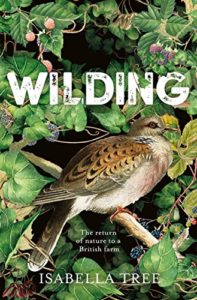 I read Wilding by Isabella Tree at breakneck speed and now I wish there was a sequel. So I could see if more peregrine falcons, nightingales and Purple Emperor butterflies arrived, and find out what happened with the pigs, and did they successfully introduce beavers into the river? What an uplifting and exciting book! It’s English (nightingales is a clue) but has so many parallels to Australian farming practices and preconceptions about our forests and wider landscape. I am sure if I dig a little, I will find a book or maybe an ABC doco about Australian wilding or as it’s often called, rewilding.
I read Wilding by Isabella Tree at breakneck speed and now I wish there was a sequel. So I could see if more peregrine falcons, nightingales and Purple Emperor butterflies arrived, and find out what happened with the pigs, and did they successfully introduce beavers into the river? What an uplifting and exciting book! It’s English (nightingales is a clue) but has so many parallels to Australian farming practices and preconceptions about our forests and wider landscape. I am sure if I dig a little, I will find a book or maybe an ABC doco about Australian wilding or as it’s often called, rewilding.
Writer Isabella Tree and her husband Charlie Burrell own Knepp Castle and its farm in Surrey. Years of intensive farming had brought them to their knees, financially. But instead of following conventional wisdom by putting even more land under the plough, using more pesticides, herbicides and fertilisers, increasing the size of their dairy herd and expanding their markets, they chose to do something very different. They didn’t do more; they chose to do less, much less, by returning 3500 acres to nature. Wilding is the story of that journey, and it’s heartening to think that sometimes, doing nothing can have such amazing results.
The speed with which the degraded pastureland changed and regenerated astonished Tree and Burrell. It took nerve, at times, not to intervene. When thistles took over a large area, they knew the surrounding landowners would soon be up in arms, demanding action. But that year, a migratory butterfly species called the Painted Lady descended on the farm and ate all the thistle leaves. The animals stomped all over the what was left, and the ants took care of the debris. The thistles were all gone, without Roundup.
Not that all of the property was left to fix itself up. The owners did a great deal of fencing, introduced animals like deer, pigs and cattle into selected areas to coppice woodland, add manure and break up the soil to regenerate vegetation. They did remediation work to the river that flowed through the farm, removing the canal and returning it to its floodplain because wetlands are not only home to wildlife, but assist with flood prevention by soaking up excess water. (They also filter run-off from farming).
Though all the work at Knepp was informed by of sound environmental science and research, as well as similar wilding projects in other countries (notably the Netherlands), the surrounding landowners took a lot of convincing. As did various government departments and funding bodies. They wanted to see what was going to happen before it did, and the couple were not equipped with crystal balls. Outdated studies on British woodland, which wrongly decreed that many species required a closed canopy to thrive, hampered their progress. I was reminded of the struggle to have Indigenous cultural burning practices accepted as part of normal forest management.
Burrell and Tree were brave souls in going against the accepted picture of an ideal English pastoral landscape because the wilded landscape is messy and ungroomed, unpredictable and surprising. Wilding, with its mix of memoir, science, history and practical environmental activism, was a feel-good and hopeful book to read in dark times.

Wasn’t it a fantastic story! Sadly my English cousins tell me they had to revert to farming at least part of the land, though some is still wild — I guess they lost all that EU funding.
I really want to see the documentary now.